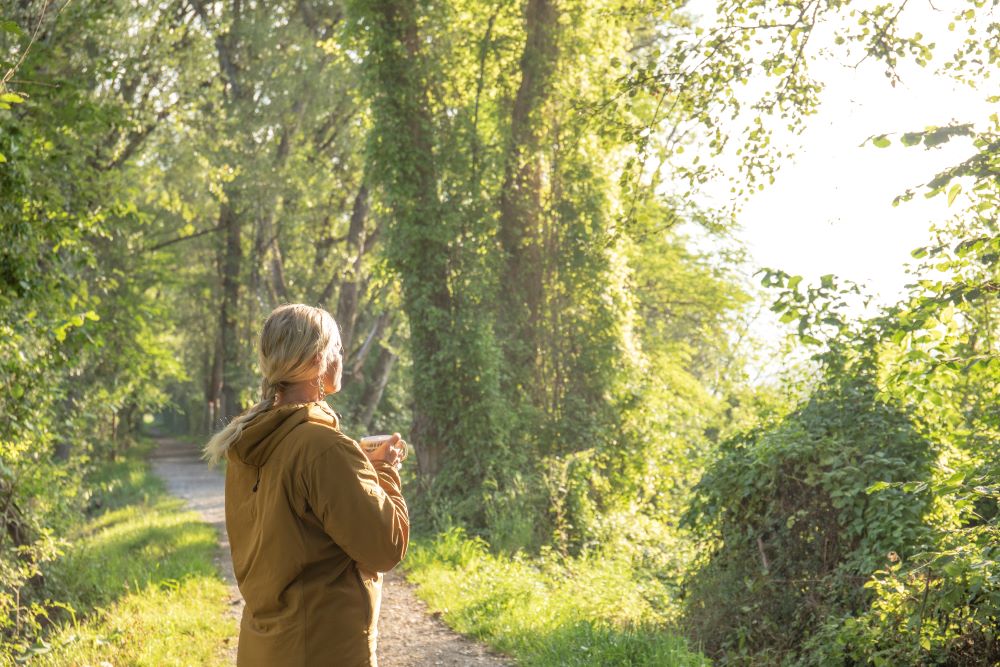More and more people now enjoy cold water swimming as part of their health and fitness routine. Some love the low-impact exercise or want to feel closer to nature, while others take the plunge to seek relief for menopause symptoms. Here we share keen swimmer Gayle O’Brien Kennedy’s story, who swam outside regularly in perimenopause to ease her menstrual cramps and sore muscles.
Find what you need quickly
Gayle’s story
When I first began my journey into outdoor swimming, menopause wasn’t on my mind. I was in my early 40s at the time and the symptoms that would soon plague me had yet to appear.
I was initially drawn to outdoor swimming’s purported benefits, including increased metabolism and improved mental health. I have always preferred exercising outside and outdoor swimming seemed like a natural choice, yet it wasn’t as simple as ‘decide then do’.
I was nervous that I wouldn’t be able to hack it, that I wasn’t cut out for the hardness and bravery required to get into a lake in March. What if it was just too cold? What if I had a panic attack in the middle of the lake? What if I couldn’t warm up afterwards and spent the rest of the day shivering under my duvet?
Getting started
Joining a local open-water swimming club was a huge factor in overcoming my fears. Their sessions included on-site wetsuit hire, marked courses, and lifeguards on kayaks. I went with a friend who had been swimming with them for a year and she talked me through what to expect.
She said cold water would come into the wetsuit but it would soon warm up and I might feel dizzy when getting out as the water drained from the wetsuit. Urgh, no problem!?!
I started slowly, doing just one 400-meter lap of breaststroke, barely putting my face in the water. I was slow and cold but warmed up. I was also nervous, but it faded when the sun came out and reflected off the lake’s small waves.
Amazing menopausal symptom relief
What I learned that day has remained true, putting your feet in is still the hardest part. The cold water takes your breath away but you get it back. As I head into perimenopause, the benefits of open-water swimming are amazing.
Perimenopause affects each of us differently with seemingly no rhyme or reason as to which symptoms will hit and when. Mine have been periods so heavy that I’ve been in restaurants when all precautions fail. Menstrual cramps are so debilitating that I feel them from my head to my heels. Hot flashes come and go without warning and my body often feels bloated and heavy like it isn’t mine anymore. I feel like my body has been taken over by some internal beast with a string of vendettas to claim.
This summer, as these symptoms came harder and faster, I have actively used outdoor swimming to help. I try to swim 2 – 3 times a week, but I have found myself adding extra sessions when I need relief from a day of hot flashes, want my heavy and cramped body to feel weightless, and when my sore muscles need a shot of cold to make them less inflamed. Outdoor swimming is also the perfect remedy when I need just a half-hour of quiet when I am uncontactable.
Find out more about aches and pains and hot flashes in our menopause symptoms library.
Getting stronger
I now really look forward to cold water swimming as part of my exercise and mental health mix. Even though swimming for me has always been more of a mental health exercise than a physical or endurance one, I have become noticeably fitter and faster in the water. More recently, I have overcome my small fear of swimming in the sea. I hope to spend the coming months exploring new rivers and beaches.
For me, outdoor swimming is here to stay. My experience is that there isn’t a single symptom of perimenopause that outdoor swimming doesn’t soothe. I don’t think I could ask for more.
Outdoor swimming tips for beginners
Interested? If you’re looking to start outdoor swimming, either to relieve symptoms of perimenopause or for any of its other benefits, here’s Gayle’s advice:
1. Find your local community
Look for other like-minded peeps – Instagram and Facebook are great for finding out who is swimming near you and where.
2. Keep watch
Always make sure the water is calm, never swim out of your depth, and always plan your way out.
3. Start slow
Don’t feel you need to swim fast or far. Just do what is right for you, whether that’s training for a triathlon or simply looking at the water. Swim your own swim.
4. You are genuinely not judged
I have never come across a more welcoming and truly-for-all activity than outdoor swimming. It is a sport for all shapes, sizes, and ages.
5. You don’t always need a wetsuit
I started with one, but I don’t use it anymore. For one, I’m lazy, but I also prefer to feel the water on my skin. When it gets colder I wear neoprene swimming gloves and shoes (a quick Google search will yield many results), which can be used with or without a wetsuit.
6. Do get a tow float
These handy inflatables attach to you with a belt and serve several useful purposes. If you get tired, you simply hold onto it for a bit. If you’re in open water, it makes you more visible to the lifeguards. Most have waterproof compartments for keys and phones.
7. Be flexible as seasons change
In the summer, I tend to swim for about half an hour – many do more, but half an hour is enough for me. In the autumn, winter, and early spring, I get out earlier rather than later, mainly to ensure I stay safe and confident. You don’t need to swim for long to reap the benefits. I once did a dip in my local river in February that lasted all of eight minutes. It was more invigorating than an espresso!
8. Dry off quickly
Quick-dry towels are a godsend – they are light, absorbent, and easy to move quickly across your body. The sooner you can get out of your suit the better – some use a toweling poncho to take their suit off while maintaining their modesty, or if you feel like splurging, get a DriRobe or similar to put on when you get out – it pulls the water away from your skin, dries you quickly, and helps keep heat in.
9. Watch for “afterdrop”
Especially as we head into colder weather, there are several easy but essential precautions you can take to make sure you don’t suffer from afterdrop, when your body struggles to warm back up after cold water immersion. Bring a hot drink and a small snack so that you warm up from the inside. Invest in a wool hat to keep the heat in your head. Put your feet into something warm and cozy – I use an old but trusty pair of Uggs.
Health benefits of outdoor swimming
Full-body workout
Swimming is an excellent form of exercise whatever the water temperature. It combines cardio and resistance training to give you a great, all-round workout. This in turn helps with your overall fitness, weight management, muscle mass, and bone density.
Menopause symptom management
Psychological menopause symptoms were reported to be the most improved by cold water swimming, according to a recent survey of more then 1,000 women. Almost half of the perimenopausal women surveyed said swimming in cold water significantly improved anxiety. Mood swings, low mood, hot flashes, depression, and irritability were also reported to be reduced.
Heart health
The cold water itself seems to have additional benefits too. Cold water swimming seems to improve a number of risk factors for cardiovascular disease, such as blood pressure. A small study found improvements in the way insulin is produced and responded to by the body, which could be of interest if you struggle with high blood sugar or diabetes.
Pain relief
Another study suggested that immersion in cold water could help to decrease pain levels, so you may find it helpful if you struggle with menopausal aches and pains. Improvements have also been found in mental health and general well-being.
These studies are promising, but doctors still don’t have enough evidence about these benefits. Likewise, we also don’t know which water temperature is most effective or which groups of people could get the most out of cold water swimming.
How to swim safely
While having fun is often the main aim, it’s important to remain aware of the risks of swimming in open water, such as in the sea, lakes, and ponds. Regardless of how strong a swimmer you are, cold water can be dangerous if you don’t prepare correctly.
Cold water shock can happen when water temperatures are below 59F. Cold water shock isn’t something you can control or “power through”.
Even strong swimmers should take care by following this advice:
- Use a wetsuit for swimming in cold water. They provide buoyancy as well as protecting you from cold water shock
- Take time to acclimatise to the cold water in the shallows before starting your swim
- Plan your exit. Ensure that there are steps, a gentle slope, or other ways to get out of the water quickly and safely if you get into trouble
- Take a flotation device such as a tow float with you
- Swim with a friend and ideally in an area with lifeguards
Learn more about safety and open water swimming.
If you have any medical conditions or risk factors, such as for heart disease, speak to your healthcare provider before taking up cold water swimming.
Final word
The best approach to outdoor swimming is one that works for you. If you enjoy cold water swimming and can do it in a safe way, fantastic! If you dread the thought of open water and shudder at the idea of pondweed tangled around your ankles, you might want to get these health benefits from other types of exercise or healthy habits.
Find out more about menopause on our blog or in our symptoms library.





